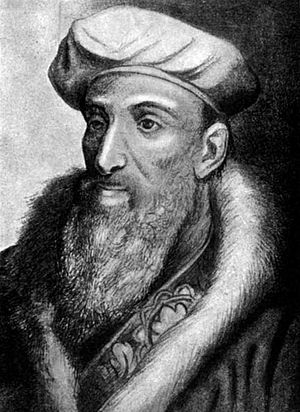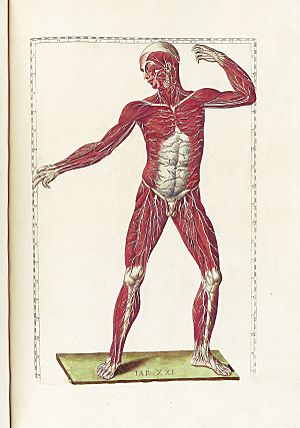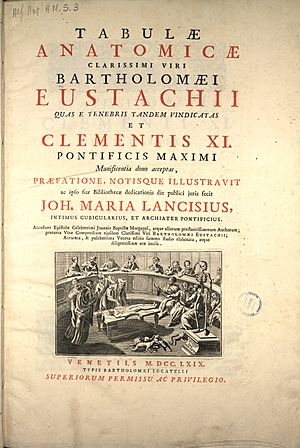Bartolomeo Eustachi facts for kids
Quick facts for kids
Bartolomeo Eustachio
|
|
|---|---|
 |
|
| Born | c. 1500–1510 San Severino
|
| Died | 27 August 1574 Fossombrone
|
| Nationality | Italian |
| Other names | Bartholom(a)eus Eustachius |
| Known for | Eustachian tube Eustachian valve |
| Scientific career | |
| Fields | Anatomy |
| Notable students | Volcher Coiter |
| Influences | Galen |
Bartolomeo Eustachi (born around 1500–1510, died 27 August 1574) was an Italian anatomist. He is known as one of the people who helped start the science of human anatomy. His Latin name was Bartholomaeus Eustachius.
Contents
Who Was Bartolomeo Eustachio?
Bartolomeo Eustachio was born in San Severino, a town in Italy. His father, Marinao Eustachius, was a rich and important doctor. Bartolomeo received a good education for his time. He studied many subjects, including different languages like Hebrew, Arabic, and Greek. This helped him read old medical books written in those languages.
He later studied Medicine at a famous university in Rome called the Archiginnasio della Sapienza. As a doctor, Eustachio was very respected by important people. He treated patients like the Duke of Urbino. In 1549, he became a professor of Anatomy at the Papal College in Rome. He also got special permission to study human bodies from a hospital. This was important for learning how the body really worked.
A Pioneer in Anatomy
Eustachio was very interested in learning about the human body by looking at it directly. He didn't just want to believe old ideas that weren't based on real observations. He wanted to see for himself.
Between 1562 and 1563, Eustachio wrote many important scientific papers. These papers were about the kidney, the ear, teeth, and the circulatory system. He studied the lower vena cava, a large vein, and its valves. One of these valves is now called the Eustachian valve. He also discovered the thoracic canal, which is part of the body's drainage system.
He put these works together and published them in 1564. The collection was called Opscula Anatomica.
Amazing Discoveries
Eustachio greatly improved our understanding of the internal ear. He rediscovered and correctly described the Eustachian tube, which is named after him. This tube connects the middle ear to the back of the throat. He was also the first to describe some tiny muscles and parts inside the ear, like the cochlea.
He was also the first to study teeth very carefully. He looked at how baby teeth fall out and how adult teeth grow in. In 1563, Eustachius also discovered the adrenal glands. These are small glands located above your kidneys.
His Famous Drawings
Eustachio's most important work was a collection of detailed drawings called Anatomical Engravings. He finished these drawings in 1552. They were made nine years after another famous anatomist, Vesalius, published his own big book on anatomy.
However, Eustachio was not able to publish his drawings during his lifetime. They were finally published much later, in 1714, by Giovanni Maria Lancisi. These drawings showed that Eustachio had studied the human body with great care. He made sure to show the correct shape, size, and position of organs.
The drawings included:
- The first seven plates showed the kidneys and parts of the ear.
- The eighth plate showed the heart, blood vessels, and the Eustachian valve.
- Other plates showed the organs in the chest and abdomen.
- One plate showed the brain and spinal cord.
- Another plate showed the nerves in more detail than ever before.
- Fourteen plates were dedicated to the muscles.
How He Studied the Body
Eustachio didn't just study the large parts of the body. He also looked at tiny structures that were too small to see with just the naked eye. He used early microscopes (called "glasses" back then) to see these small parts.
He also used different methods to study body parts closely. For example, he would soak them in fluids or dry them out to make them clearer. He also compared healthy body parts with sick ones to understand how diseases affected them. He worked with Pier Matteo Pini to create 47 detailed drawings of these organs.
Eustachius was a supporter of Galen, an ancient Roman anatomist. He even had a public debate with Vesalius, another important anatomist of his time. Both Eustachius and Vesalius learned about anatomy by studying human bodies.
Eustachius died in 1574 in Umbria, Italy, while traveling.
His Writings
- Bartolomeo,Eustachi (1564), "Opuscula Anatomica"
- Bartolomeo Eustachi (1728), Tabulae anatomicae – a digital copy from the Linda Hall Library
See also
 In Spanish: Bartolomeo Eustachio para niños
In Spanish: Bartolomeo Eustachio para niños



